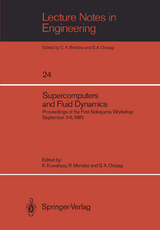Supercomputers and Fluid Dynamics
Springer Berlin (Verlag)
978-3-540-17051-8 (ISBN)
Secondary Instabilities, Coherent Structure, and Turbulence.- Bootstrapping in Turbulence Computation.- Development of High-Reynolds-Number-Flow Computation.- Spectral Element Simulation of Flow in Grooved Channels: Cooling Chips with Tollmien-Schlichting Waves.- A Vortex Ring Interacting with a Vortex Filament and its Deformation Near the Two-Dimensional Stagnation Point.- A New Three-Dimensional Vortex Method.- Multi-Cell Vortices Observed in Fine-Mesh Solutions to the Incompressible Euler Equations.- Implicit Boundary Treatment for Joined and Disjoint Patched Mesh Systems.- Computational Study of Three-Dimensional Wake Structure.- A Semi-Elliptic Analysis of Internal Viscous Flows.- Simulation of Self-Induced Unsteady Motion in the Near Wake of a Joukowski Airfoil.- Viscous Compressible Flow Simulations Using Supercomputers.- The Scalar Performance of Three Supercomputers: Cray's X-MP/2, Fujitsu's VP-200 and NEC's SX-2.- NEC Supercomputer SX System.- FX: A CMOS-Implemented Digital Spectro-Correlator System for Radio Astronomy.- The CRAY-2: The New Standard in Supercomputing.- to the ETA 10.
| Erscheint lt. Verlag | 1.10.1986 |
|---|---|
| Reihe/Serie | Lecture Notes in Engineering |
| Zusatzinfo | VIII, 206 p. 17 illus. |
| Verlagsort | Berlin |
| Sprache | englisch |
| Maße | 170 x 244 mm |
| Gewicht | 381 g |
| Themenwelt | Informatik ► Weitere Themen ► CAD-Programme |
| Naturwissenschaften ► Physik / Astronomie ► Mechanik | |
| Naturwissenschaften ► Physik / Astronomie ► Strömungsmechanik | |
| Technik | |
| Schlagworte | Computer • Development • Dynamics • fluid- and aerodynamics • Fluid Dynamics • Science • Simulation |
| ISBN-10 | 3-540-17051-0 / 3540170510 |
| ISBN-13 | 978-3-540-17051-8 / 9783540170518 |
| Zustand | Neuware |
| Haben Sie eine Frage zum Produkt? |
aus dem Bereich




